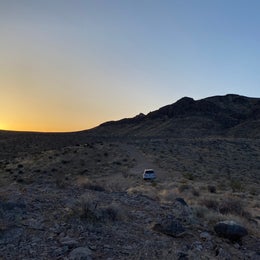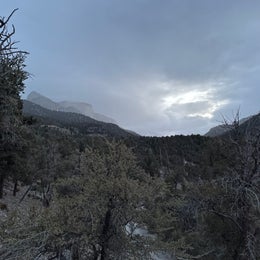Top Dispersed Camping in Nevada
Looking for the best Nevada dispersed camping? Dispersed camping is the perfect way to get off the grid. Each dispersed site offers quick access to one or more of Nevada's most popular destinations.
Looking for the best Nevada dispersed camping? Dispersed camping is the perfect way to get off the grid. Each dispersed site offers quick access to one or more of Nevada's most popular destinations.
A large part of the Spring Mountains is remote and undeveloped. Visitors can venture out and set up camp in these remote areas with just a little planning from the guidelines below
The best known areas in the Spring Mountains include Mack's Canyon, Champion Road, and Lovell Canyon but those can get crowded in warm weather. Dispersed camping is NOT allowed in the vicinity of developed recreation areas such as campgrounds, picnic areas, or trailheads. Many people drive or hike out on Forest Service roads into the woods and find a clearing or a spot with a nice view or good shade. Do not drive on meadows to access your camping site. Drive on existing roads to prevent resource damage. Dispersed camping is allowed outside a one-mile perimeter away from campgrounds and 100 feet from any stream or spring. To prevent resource damage please keep your campsite within 150 feet from a roadway.
How to Pick a Campsite If you are going to an area where others have camped before, pick a site that has been used before. Plants, soil and wildlife are impacted by new campsites so using existing ones will minimize your impact in the forest. If there is no existing campsite, then follow these Leave No Trace guidelines.
Do NOT camp within 100 feet of any water source, as plants near water are especially fragile.
Going to the Bathroom in the Woods Dispersed camping means no bathrooms and no outhouses. That means extra care has to be taken in disposing of human waste. To dispose of feces, dig a hole six (6) inches deep at least 100 feet away from any water source. When you are done, fill the hole with the dirt you dug up and take your toilet paper with you to dispose of in a proper waste container. A ziplock bag is helpful for this. Never defecate or leave toilet paper on top of the ground since it could easily get into the local water source and contaminate it.
Treating Your Water We used to be able to take a cup and drink directly out of the sparkling creek, a rushing waterfall, or a clear, deep lake. There is NO safe water source anymore. With an increasing population and visitation to the Spring Mountains, water sources have been contaminated with invisible micro-organisms that can make people very ill and even kill them in some cases. Giardia is a common contamination that has been spread through improper toileting and wild animals to many water sources. It will cause diarrhea, cramping, and other physical problems. The only way to ensure that water from any undeveloped source is safe is to treat it. That means heating it until it comes to a rolling boil, using water purification tablets or a water purification filter. Water from faucets in developed recreation areas has been tested and treated and is safe to use without treating.
A network of backcountry roads has been developed within the park to provide access to the lakeshore and other areas of interest that are off the beaten path. Approved roads are signed with a yellow arrow. The black number in the center of the arrow designates the road number. Driving on roads or trails not marked with the yellow arrow is prohibited.
With hundreds of miles of backcountry roads, conditions can change without notice. Please travel on backcountry roads with caution. Driving off roads, in washes or cross country damages the fragile desert soil and is prohibited by National Park Service regulations.
Please help preserve the park by staying on approved roads, respecting the rights of other visitors and carrying out all trash and litter.
Camping on public lands away from developed recreation facilities is referred to as dispersed camping. Most of the remainder of public lands are open to dispersed camping, as long as it does not conflict with other authorized uses or in areas posted "closed to camping," or in some way adversely affects wildlife species or natural resources.
Dispersed camping is allowed on public land for a period not to exceed 14 days within a 28 consecutive day period. The 28 day period begins when a camper initially occupies a specific location on public lands. The 14 day limit may be reached either through a number of separate visits or through 14 days of continuous overnight occupation during the 28 day period. After the 14th day of occupation, the camper must move outside of a 25 mile radius of the previous location until the 29th day since the initial occupation. The purpose of this special rule is to prevent damage to sensitive resources caused by continual use of any particular areas. In addition, campers must not leave any personal property unattended for more than 10 days (12 months in Alaska).
Campsite Selection Dispersed camp sites are located along most secondary roads and may not be marked. Popular locations can be recognized by the telltale flat disturbed area that has been used as a camp site before. Not all flat spots are sites. If possible, please use existing sites to avoid creating new disturbances. To further protect your public lands, campers must not dispose of any refuse, hazardous materials, sewage, or in any manner pollute the surrounding area.
$50 / night
Access to Kirch WMA is free—even for overnight camping. Please make sure that you’ve got an up to date fishing license, if you plan to fish.
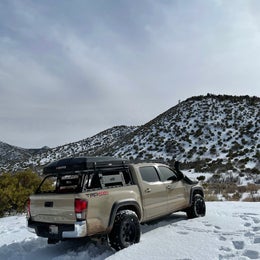
A large part of the Spring Mountains is remote and undeveloped. Visitors can venture out and set up camp in these remote areas with just a little planning from the guidelines below
The best known areas in the Spring Mountains include Mack's Canyon, Champion Road, and Lovell Canyon but those can get crowded in warm weather. Dispersed camping is NOT allowed in the vicinity of developed recreation areas such as campgrounds, picnic areas, or trailheads. Many people drive or hike out on Forest Service roads into the woods and find a clearing or a spot with a nice view or good shade. Do not drive on meadows to access your camping site. Drive on existing roads to prevent resource damage. Dispersed camping is allowed outside a one-mile perimeter away from campgrounds and 100 feet from any stream or spring. To prevent resource damage please keep your campsite within 150 feet from a roadway.
How to Pick a Campsite If you are going to an area where others have camped before, pick a site that has been used before. Plants, soil and wildlife are impacted by new campsites so using existing ones will minimize your impact in the forest. If there is no existing campsite, then follow these Leave No Trace guidelines.
Do NOT camp within 100 feet of any water source, as plants near water are especially fragile.
Going to the Bathroom in the Woods Dispersed camping means no bathrooms and no outhouses. That means extra care has to be taken in disposing of human waste. To dispose of feces, dig a hole six (6) inches deep at least 100 feet away from any water source. When you are done, fill the hole with the dirt you dug up and take your toilet paper with you to dispose of in a proper waste container. A ziplock bag is helpful for this. Never defecate or leave toilet paper on top of the ground since it could easily get into the local water source and contaminate it.
Treating Your Water We used to be able to take a cup and drink directly out of the sparkling creek, a rushing waterfall, or a clear, deep lake. There is NO safe water source anymore. With an increasing population and visitation to the Spring Mountains, water sources have been contaminated with invisible micro-organisms that can make people very ill and even kill them in some cases. Giardia is a common contamination that has been spread through improper toileting and wild animals to many water sources. It will cause diarrhea, cramping, and other physical problems. The only way to ensure that water from any undeveloped source is safe is to treat it. That means heating it until it comes to a rolling boil, using water purification tablets or a water purification filter. Water from faucets in developed recreation areas has been tested and treated and is safe to use without treating.
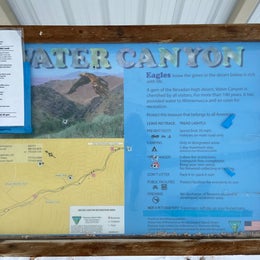
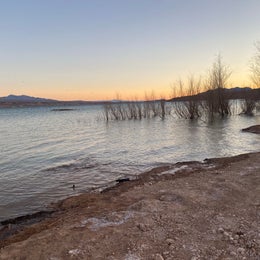
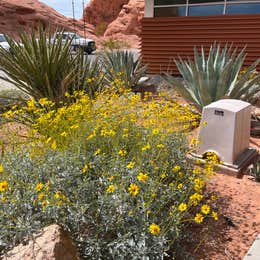
Camping on public lands away from developed recreation facilities is referred to as dispersed camping. Most of the remainder of public lands are open to dispersed camping, as long as it does not conflict with other authorized uses or in areas posted "closed to camping," or in some way adversely affects wildlife species or natural resources.
Dispersed camping is allowed on public land for a period not to exceed 14 days within a 28 consecutive day period. The 28 day period begins when a camper initially occupies a specific location on public lands. The 14 day limit may be reached either through a number of separate visits or through 14 days of continuous overnight occupation during the 28 day period. After the 14th day of occupation, the camper must move outside of a 25 mile radius of the previous location until the 29th day since the initial occupation. The purpose of this special rule is to prevent damage to sensitive resources caused by continual use of any particular areas. In addition, campers must not leave any personal property unattended for more than 10 days (12 months in Alaska).
Campsite Selection Dispersed camp sites are located along most secondary roads and may not be marked. Popular locations can be recognized by the telltale flat disturbed area that has been used as a camp site before. Not all flat spots are sites. If possible, please use existing sites to avoid creating new disturbances. To further protect your public lands, campers must not dispose of any refuse, hazardous materials, sewage, or in any manner pollute the surrounding area.
